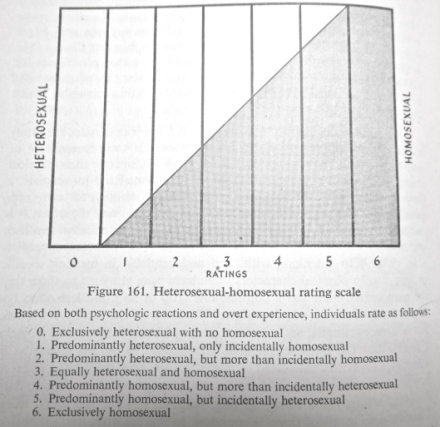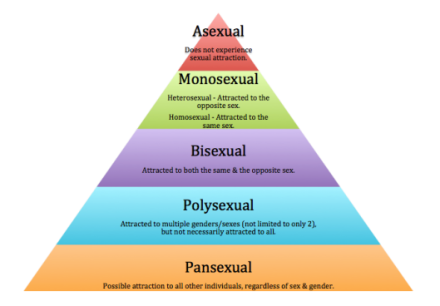Some people are most comfortable with a black & white view of sexual orientation where your only option is monosexuality: either strictly heterosexual or strictly homosexual. These individuals do not acknowledge that bisexuality exists — either claiming that a “bisexual” is really just a gay/lesbian in denial or a straight person who is experimenting. Others support a third category for bisexuality, accepting a valid middle ground where a person truly can be attracted to both males & females.
While I recognize that categorizing things in nice, neat boxes makes us feel more at ease, I also believe that it can lead to an “us vs. them” mentality. Plus, it encourages us to overlook the subtle differences and intricate details of human sexuality. That’s why I support a broader view of sexual orientation that falls along a continuum. Sexual continuums are not a new idea, but they are sometimes met with resistance.
Kinsey Scale
Published in Alfred Kinsey’s 1948 Sexual Behavior in the Human Male, the Kinsey Scale is a concept that is fairly widely known and pretty simple to grasp. Basically, the scale runs from 0 (exclusively heterosexual) to 6 (exclusively homosexual).

Fig. 16.1 is reprinted from page 638 of Sexual Behavior in the Human Male by A. Kinsey, W. Pomeroy, & C. Martin (1948).
The fact that #1-5 all describe bisexuality should make it obvious that there is a lot of diversity even within a group of individuals sharing the same sexual label. Although the Kinsey Scale allows for more wiggle room in how a person subjectively defines their sexuality, it can also get a little murky if sexual attraction widely differs from actual sexual experience — or if these aspects change/become more fluid over time.
Klein Grid
Developed by Fritz Klein in 1978, the Klein Sexual Orientation Grid aimed to expand and enhance Kinsey’s idea of a sexual continuum. To get a more complete view of one’s sexuality, the Klein Grid looks at…
- sexual as well as nonsexual aspects of interpersonal interaction
- experience, attraction, fantasy, and self-identification (all separately)
- and the individual’s past, present, and future ideal orientation.
If you would like to take an online quiz version of the Klein Grid, you can do so here. For some individuals, the result may be the same as with the Kinsey Scale — or it may differ. Personally, when I took the Klein quiz, I scored almost a full number higher than I usually self-indentify on the Kinsey Scale. My partner, on the other hand, scored half a number lower.
Beyond the Binary: Pansexuality & Polysexuality
One thing that neither Kinsey nor Klein considered was the existence, and attraction to, individuals that do not fit into our society’s sex and/or gender dichotomy. Even when discussing bisexuality, everything is always “male” or “female,” biological “men” or biological “women.” This means that intersex individuals and those whose gender is more fluid are ignored. But a person’s sex or gender is not always a determining factor in whether or not we are attracted to them.
Those who identify as pansexual remove the constraints of sex & gender binaries altogether, affirming that they can be attracted to anyone — including people of all possible sexes and genders. While some pansexual individuals may have preferences, they remain open to any attraction they experience, focusing more on the person as an individual.
Polysexuals are similar to pansexuals in that their love is not limited to strict societal binaries. However, unlike pansexuals, they may still have some groups of individuals who they are not attracted to based on sex or gender.
Asexuality
Individuals who identify as asexual do not experience sexual attraction to anyone, regardless of sex or gender. While Kinsey did discover a small percentage of people who he described as having “no socio-sexual contacts or reactions,” it was only mentioned in passing. Even now, there is a surprising lack of scientific research regarding asexuality — but a growing community has surfaced. (The Asexual Visibility & Education Network, or AVEN, is a fantastic resource.)
Asexuality can vary widely, depending on the individual. Some experience sexual arousal, but no desire to necessarily share that experience with another person. Some choose to engage in sexual activity without personally feeling sexual desire. Some individuals also inhabit a “gray area” between sexual and asexual which they have defined as being gray-sexual or “gray-a.” This may mean that they go through periods of being asexual, followed by periods of being sexual or it may mean that they experience very little sexual attraction, only under certain circumstances. (For example: Demisexual individuals only experience sexual attraction after an emotional bond has been formed.)
Because this is a more complex view of sexual orientation, it may help to envision a pyramid of how many individuals a person of each orientation may potentially be attracted to — based on the sex or gender of the other person.
Sexual Orientation vs. Romantic Orientation?
Although many definitions for “sexual orientation” include a romantic component, it is important to remember that sexual attraction and romantic attraction can be very separate. Many (but not all) asexuals experience romantic attraction and desire companionship without sex. And a person that is sexually attracted to one gender or sex may be romantically attracted to another. For example, an individual may be heterosexual in that they desire sexual activity with the opposite sex and biromantic, desiring a romantic connection with members of the same and opposite sex. For every sexual orientation term, there is a romantic orientation equivalent (ex: heterosexual/heteroromantic, bisexual/biromantic, asexual/aromatic, etc) and a person has one of each.


